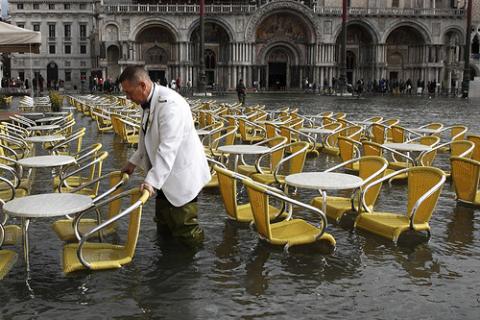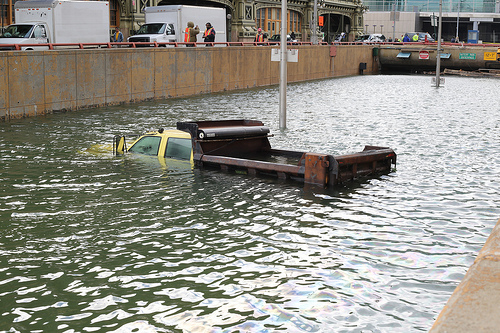Everything that rises must converge

Last week’s unprecedented inundation of New York and, simultaneously, an almost-routine immersion of Venice both highlighted capitalism’s indifference to the fragility of urban life, writes Harry Browne.
My mother, it appeared, was right in the path of the storm. The home Flavia shares with her husband (he is, I’m afraid, really called Sandy) is in a little place called Bridgeton, New Jersey; and in the hours before what we were then calling Frankenstorm made landfall, none other than Bridgeton looked like the first full-fledged town over which its centre was projected to pass. I thought of the big trees that tower over her garden, and the flood-prone river that flows below it, and I worried.
My worry carried extra layers of guilt and affection, because as the storm approached I was preparing to set off with my family on a quick birthday trip to sunny Italy, to the region where my mother fled to give birth to me nearly a half-century ago. (It’s a long story.) By the time we got to Venice, however, I knew she and her rural American town were fine - Sandy, the storm that is, wimped out as it struck land - and the real trouble was further north. My brother’s Brooklyn neighbourhood was convulsed by the deaths of a young couple who picked the wrong time to walk their dog: a falling branch killed them both. My sister-in-law and her family were without power, and would stay that way for days.
Although our loved-ones were basically okay, it felt a little obscene to bask in the beauty of La Serenissima. But just a little.
Then, just before lunchtime on our second day in Venice, it started to rain. It didn’t seem like a lot of rain. It drizzled. Then it spit. But it never really poured. It was only a little worse than what we’d call here a “soft day”.
The Aqua Alta (high water) that characterises high tide in Venice, especially when the moon is full, had already given us a few moments of inconvenience and annoyance - the puddle outside our hotel door, running into its lobby, where a tiny nearby canal overflowed; the passarelle (long tables) that seemed to be laid out for pedestrians in places that were dry rather than in some of the flooded alleys. Little did we know that the tables had been set out not to deal with the day’s minor flooding but in anticipation of worse to come: those alleys that had flooded already were a lost cause. That night when the tide rose again, and once the rain waters had begun to make their contribution to the level of Venice’s lagoon, we watched as our mostly high-lying square filled up completely. The Sicilian restaurateur across the way stood in his business’s elevated doorway as though his presence could stem the tide, and water rushed around the Campo San Stefano in what looked like a frantic search for its level - a level that only began to decline after 2am, after it had achieved heights not seen for nearly two years, apparently almost a metre and a half above the historic norm.
Even with the tide out in the morning we waded in brine nearly to our knees. Venice was functioning, matter-of-fact about it all, the occasional warning siren just another few notes in the city’s watery music. We caught a vaporetto to the train station and made good our escape, just slightly ahead of schedule, to drier spots in Veneto, such a pretty and prosperous Italian region.
By contrast, much of New York was devastated by what may or may not prove to be a once-in-a-generation confluence of almost-hurricane, weather front and tide. Those who insist on definitively attributing Superstorm Sandy to man-made climate change are playing a statistical mug’s game: while undoubtedly the last half-century’s small amount of anthropogenic warming is part of this storm’s vast and chaotic back-story, it is not yet possible to say with certainty if that warming made a storm of this destructive magnitude more likely, which is what the attribution question really boils down to. (This question is, I hardly need to add, subject to debate.) Certainly, too, New York was made more vulnerable by the fact that sea-levels there have gradually risen a foot-and-a-half in the last 150 years, but again the causes of that go beyond atmospheric carbon levels, and Sandy’s 17-foot surge rather dwarfed that effect.
 Floodwater in the Hugh L. Carey tunnel (Battery Park tunnel) after Hurricane Sandy
Floodwater in the Hugh L. Carey tunnel (Battery Park tunnel) after Hurricane Sandy
When we ask, “Why was New York so vulnerable?” we’re not just asking about the climate or the weather, and our political response shouldn’t be limited to climate-change point-scoring against the forces of “denial”. Rather, it seemed to me as I stared grimly out at the water rising under a Venetian streetlamp - worried again, this time about getting my young daughter out of there - that thinking about the routine vulnerability of Venice might offer some guidance in considering the rarer and more dangerous vulnerability of Manhattan and its surrounds.
Venice and New York have more in common than their beautiful and dramatic orientation toward the sea. Venice was for centuries the original “world trade centre”, and built a globe-spanning empire on commerce and military might, mostly without directly ruling the places and peoples in its orbit. Like New York, the wealth this generated is inseparable from its glory.
Unlike New York, where construction that flies in the face of tidal sense has taken place where and when planning authorities should have known better, the old urban centre of Venice was built, quite brilliantly, at safe elevations in a remarkably protected natural environment, and in its golden age flooding was rare.
Not that environmental stupidity and hubris haven’t made their contribution in Italy. The factors that have brought sea and city into such frequent and damaging contact in recent years are, again, complex, and the ways to address them much debated. The pumping out of precious groundwater from the Venetian islands’ delicate aquifers has been, appropriately, much discussed. Less considered has been the rapid and poorly planned 20th-century industrialisation of the vast wetlands around the edge of the lagoon, so visible as you fly into Venice and see the city itself standing out in such sharp contrast to what stands near it, which is about as scenic as the New Jersey Turnpike.
As in New Jersey and New York all that man-made stuff chokes the paths of the water and gives it fewer places to flow. The truly, terribly stupid thing about Venice’s plight isn’t so much that it is vulnerable to the sea - its excellent location means that its worst-ever Acqua Alta, in 1966, was way below half of what New York faced last week - but that it is so vulnerable to mere rain. Rain water from the surrounding region enters the lagoon at dozens of points, and over-development means that it rushes toward the city. The sort of clever engineering that might have ensured the water went elsewhere was instead devoted, by the short-termist, profit-seeking logic of capitalism, to ensuring that it has nowhere else to go.
I don’t have the expertise to assess the sea defences for Venice that have been promised, delayed and overspent-on for so many decades, and that may or may not finally be in place in the next few years. But you don’t need to be an engineer to know that the last half-century of inaction and wrong-action has killed Venice. To be sure, not all traces of the city that used to live in this lagoon are gone: some of them survive, beautifully and poignantly, despite the loss of the vast majority of its people since the 1950s; today the population of the old city stands below 60,000, and if it weren’t for some decent postwar social housing it would probably be much lower still. But as a living, live-able city it is dead, killed by the market forces that drove the replacement of its native population by apartments that sit empty until holidaymakers and the global rich feel like dropping in; and the accomplice in the crime were the market forces that send the water rushing in with increasing frequency, making it an awkward, if not an impossible place to think about living a normal, year-round life.
As befits a city with so few of its people remaining and so much money to be made from property speculation and tourism, the resistance in Venice is weak and diffuse. There is at least one group that has staged protests and issued demands to curb neoliberalism’s worst Venetian excesses and rebuild a living city in place of what they call “Veniceland”. But while capitalism and its appetites remain in charge in Venice, you’d need the powers of Dr Frankenstein himself to bring it to life.
In New York, just as nature packs a bigger punch, the forces of capitalist environmental indifference are that much bigger too. New York was warned repeatedly about its vulnerability, but its profiteers carried on with construction projects that defied the elements, building on crucial flood plains, and its utilities didn’t invest in infrastructure that could have survived Sandy’s surge. But New York City, despite the transformation of much of Manhattan into something like Big Appleland, is very definitely alive, and is also potentially one of the world’s great sites of resistance; as Chris Williams has written, it can be restored with a new sensitivity to its natural environment that would defy neoliberal priorities.
Sandy was an act of nature; much of the disaster, however, was man-made. And even in recovering from it, the disaster’s victims believed they could see priorities that had as much to do with class, visibility and status as with need. In New York as in Venice, if we want our cities to be safe and suitable for their people, we have to ensure they are built for us, and not for the rapacious elites whose wake is a trail of destruction as distinctive as any storm’s.
Image top - St Mark's Square, Venice, October 2012: Roberto Trm.
Image centre: WarmSleepy.
